Bread in Bread Again Dum Dum Dum Dum Bread Again Bread Again Te Worlds Most Famous Bread
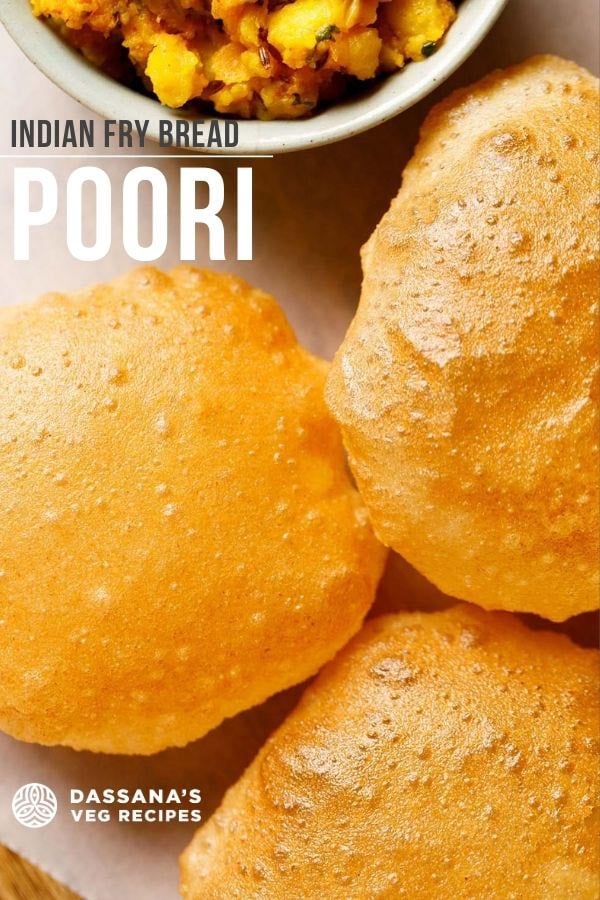
Poori or Puri is a traditional Indian fried bread that is delicious to enjoy with almost any main dish. It's a simple unleavened bread made from just whole wheat flour, table salt, and water. Hither I share my poori recipe with step-past-pace photos and the best tips for making puri at domicile – crispy, fluffy, and soft and I bet you'll love making homemade puri to bask with your favorite meals!
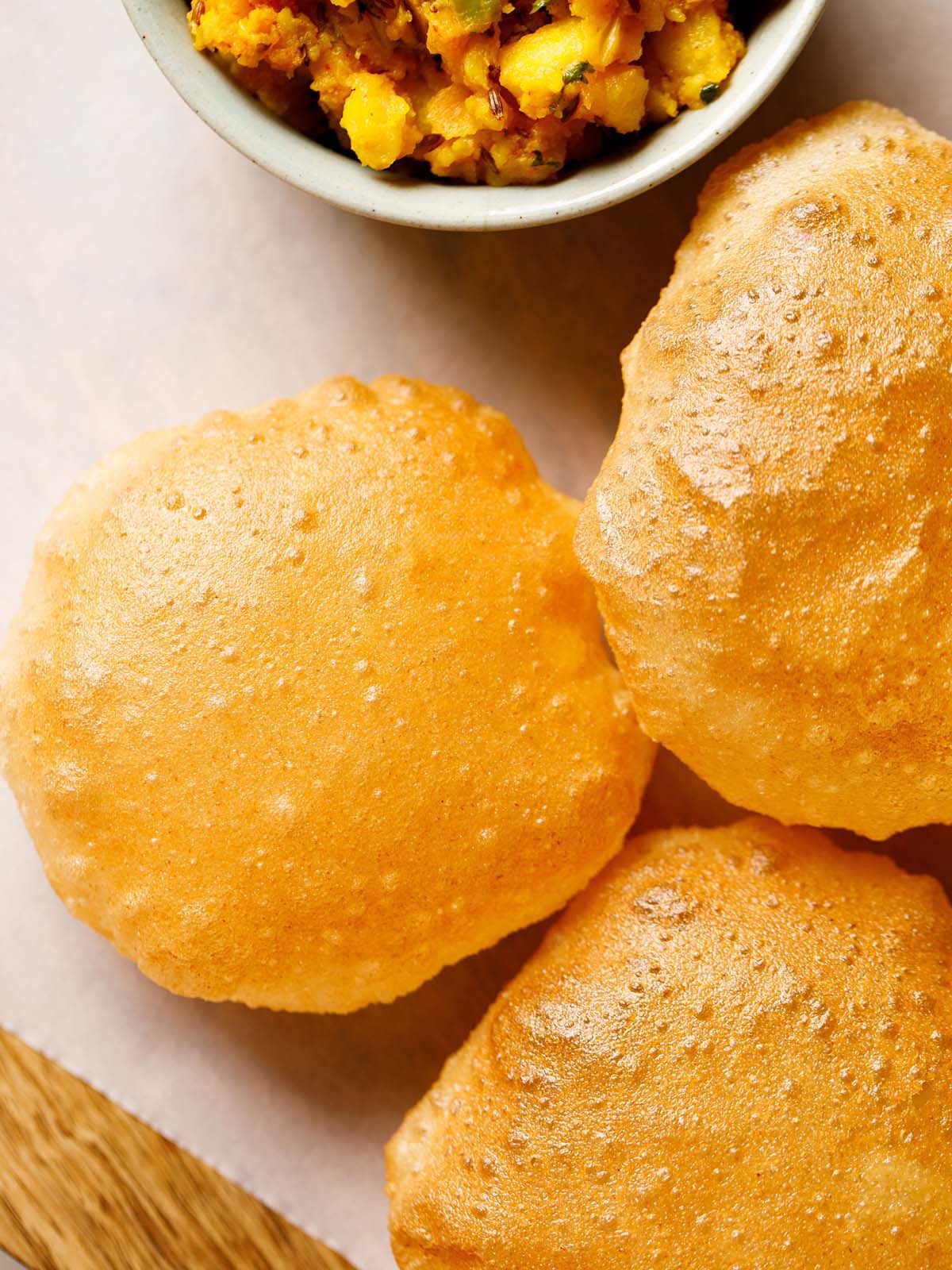
- Almost Poori
- How to Make Poori (Stepwise Photos)
- Expert Tips
- FAQs
- Recipe Card
Virtually Poori
A bones poori recipe is fabricated with whole wheat flour, common salt, and h2o. These are simply 3 ingredients you need. A bit of oil or ghee tin be added to the whole wheat dough optionally. The dough is not leavened or fermented, so it's a wonderfully quick and piece of cake bread to brand.
Minor balls of dough are rolled and flattened, and apace fried in hot oil. The poori puffs upwardly to create light, crispy pillows that just beg to be bitten into. Inside is soft and tender, and perfect for using to scoop upwards a hearty curry.
Make a batch of this poori recipe for a snack at present or for your dinner tonight, then accept leftovers with breakfast in the morn. There is never a wrong time to savor soft and crispy poori!
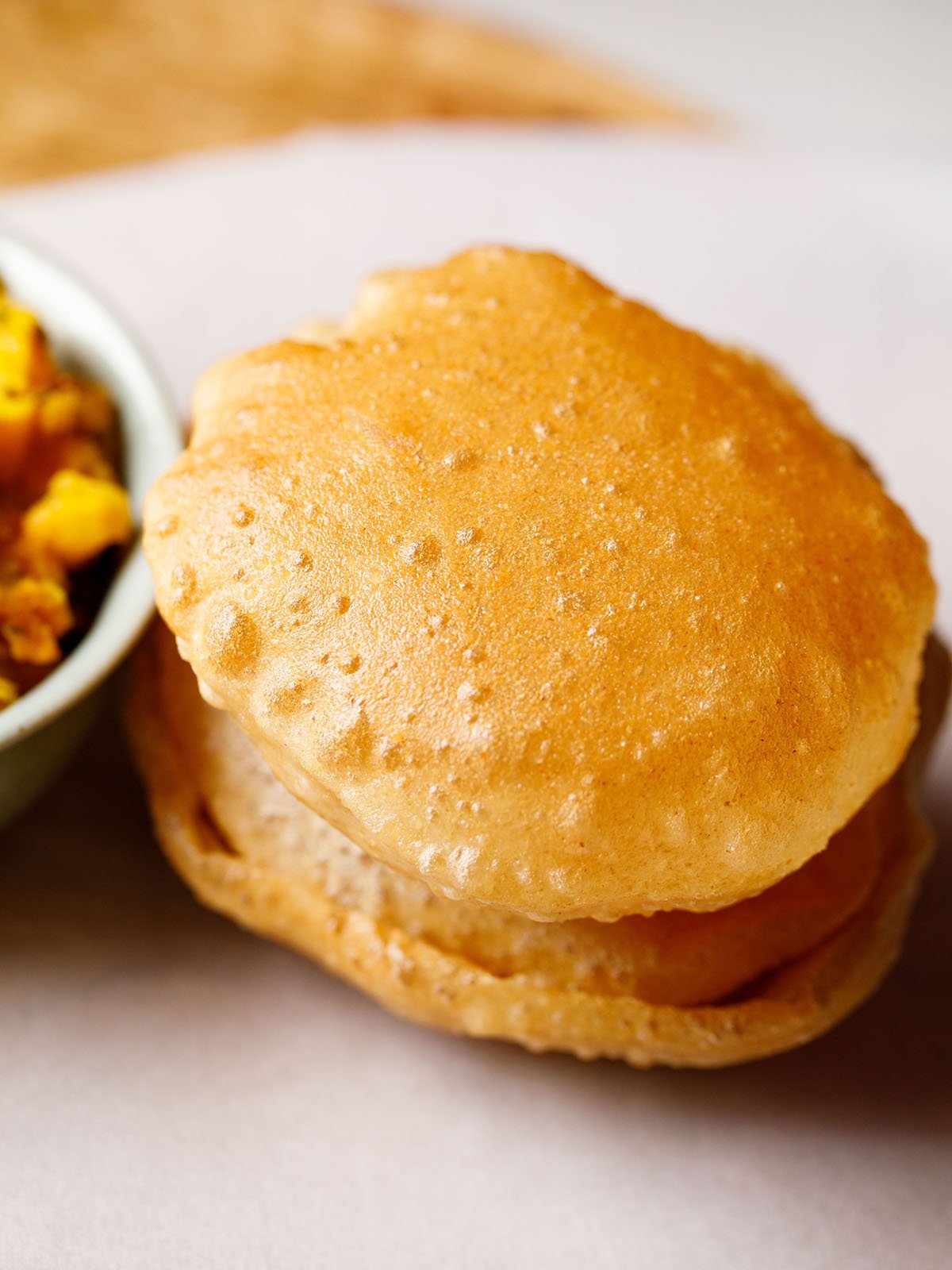
Footstep-by-Step Guide
How to Make Poori
Bootleg puri only takes about 40 minutes to make from start to stop. Be sure to read the unabridged poori recipe, including my Tips for the All-time puri below before yous get started!
Making the Dough
1. First, mix together 3 cups whole wheat flour (360 grams), ane teaspoon salt, and 1 teaspoon oil (optional) in a large basin. For more crispy puri, yous can add ¼ cup fine rava (sooji or semolina).

two. Add together just a chip of h2o at a time as yous begin to form the dough, making sure to not oversaturate the mixture.
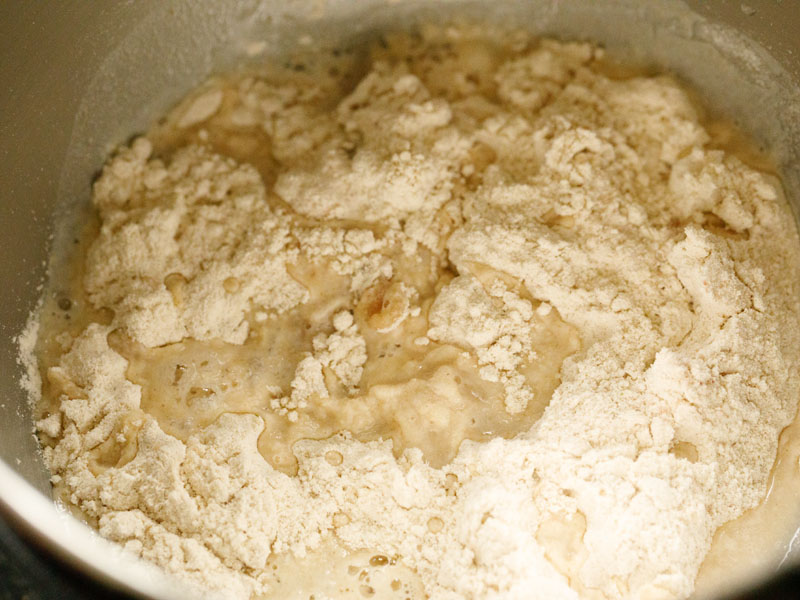
3. Knead the dough with a wooden spoon or your hands, or utilize a continuing mixer. Again, add simply a splash or two of water at a fourth dimension every bit you work.
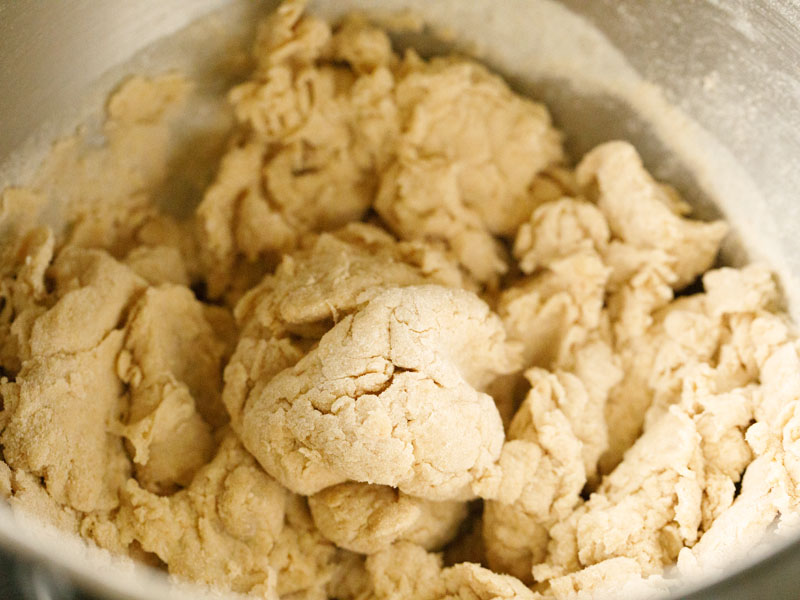
4. Keep to knead until you form a stiff, tight dough. Information technology should not be soft like a roti or a staff of life loaf. You can add almost ¾ to 1 cup of h2o in full.
Cover the bowl with a kitchen towel or plastic wrap, and let the dough rest for twenty to 30 minutes at room temperature.
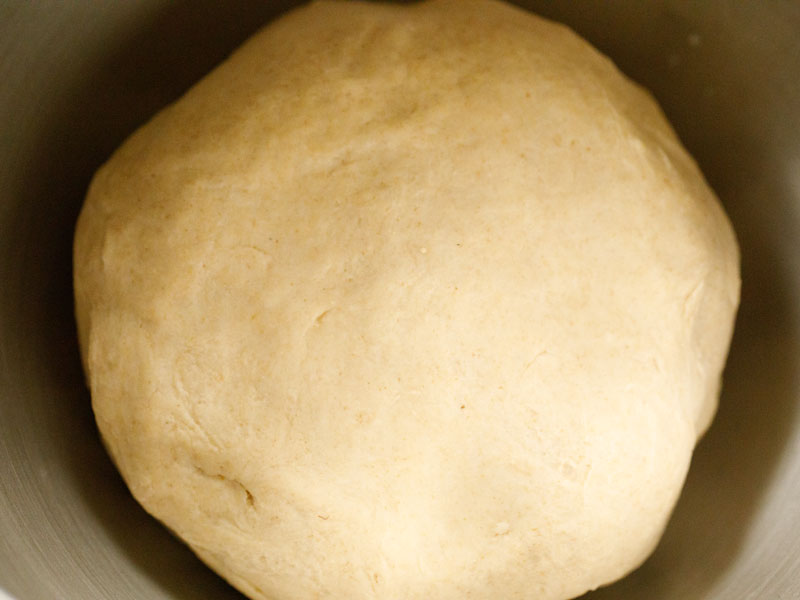
Forming Poori
5. When ready to employ, dissever the dough into most xxx small or 25 medium pieces, and whorl each into a tight ball.
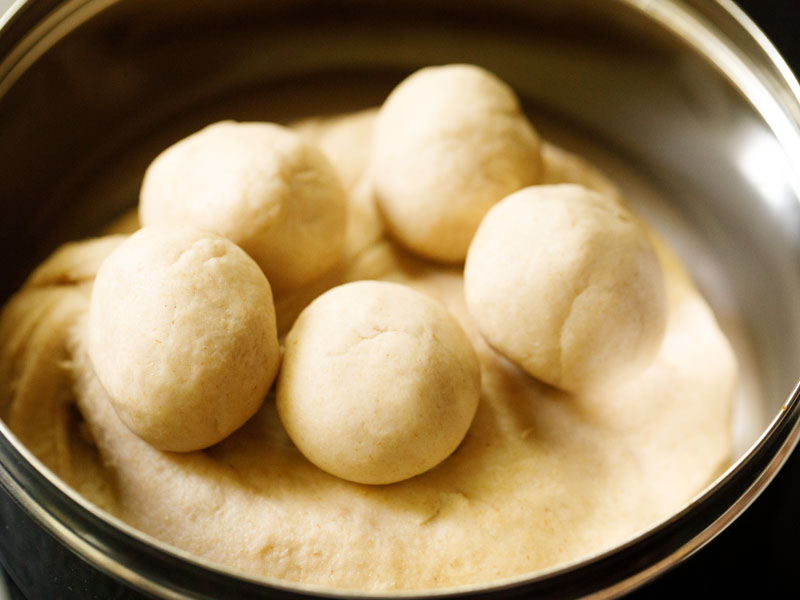
6. Next, employ the palm of your hand to lightly flatten the dough ball, and then employ a scrap of oil to the unabridged surface. This helps the bread fry evenly and rise properly, without the need to dust with flour first (which runs the risk of creating burnt flour particles in your oil).
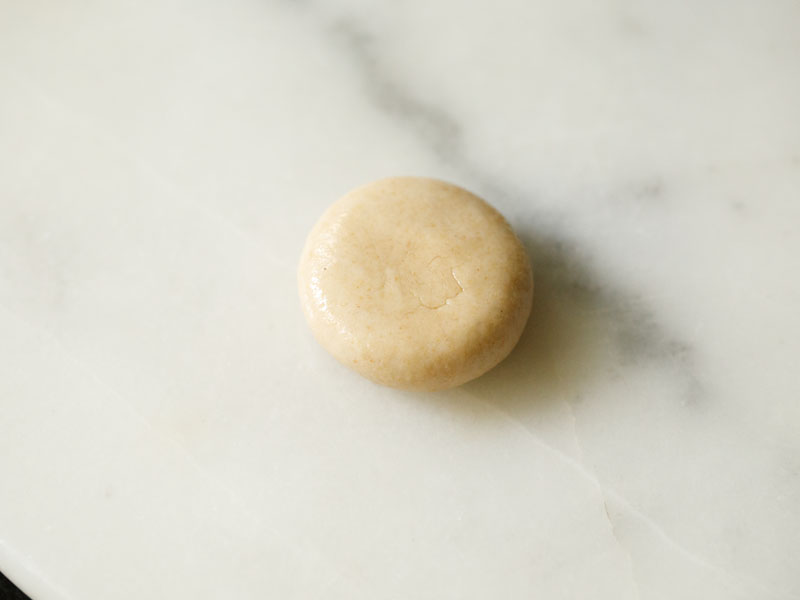
7. Use a rolling pin to gyre the poori dough evenly into circles that aren't too thick or too thin. Ideally, you desire them to be nigh ¼ inch thick.
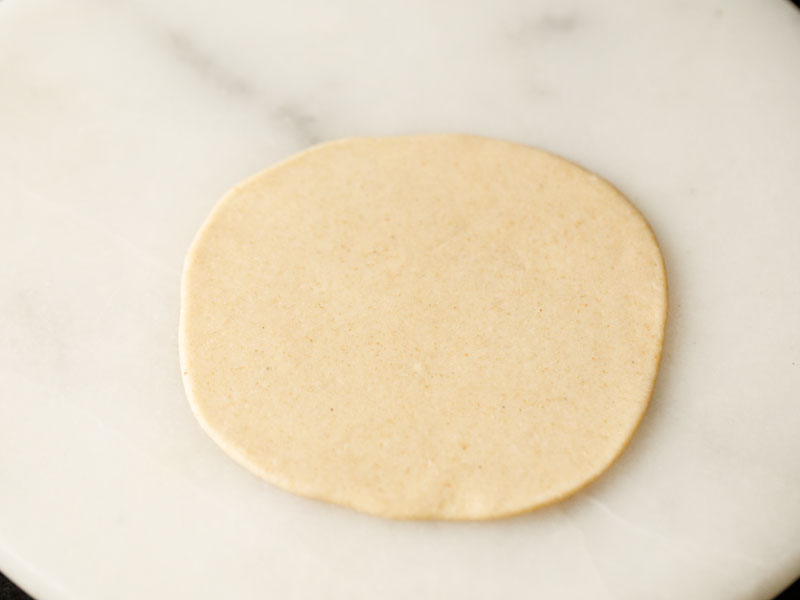
eight. Then place the rolled poori on a plate, and loosely cover with a clean kitchen towel then that they don't dry out.
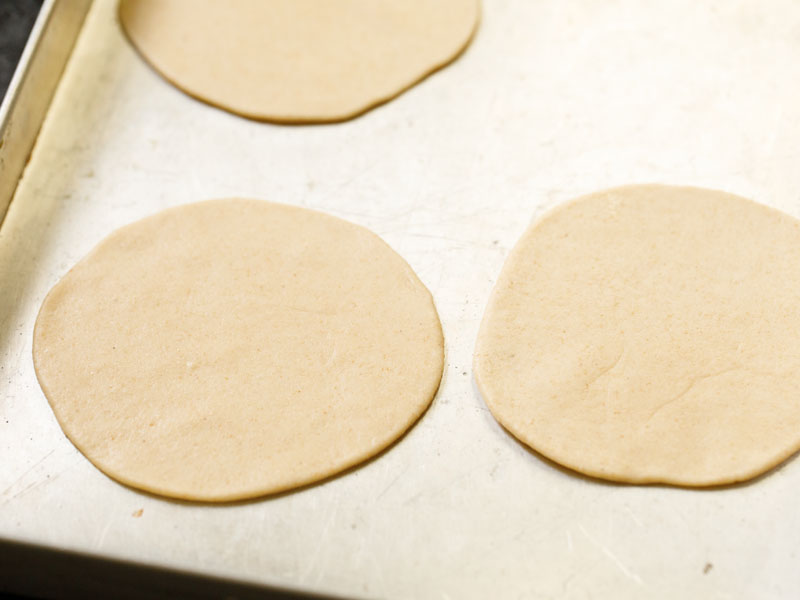
Frying Puri
While information technology is easy to fry puri at dwelling house, it does accept a gentle touch. Because they need to puff up you should be extra careful not to crack them, otherwise oil will seep into the dough as information technology cooks and get soggy.
Follow these simple steps for making certain you lot fry perfect puri every time:
nine. Offset, heat oil in a deep pan (kadai). Exam the oil past dropping a small-scale dough ball into oil. If it rises chop-chop to the meridian, then the oil is hot plenty for frying.
Once y'all have the oil to the right temperature, carefully add one puri at a time.
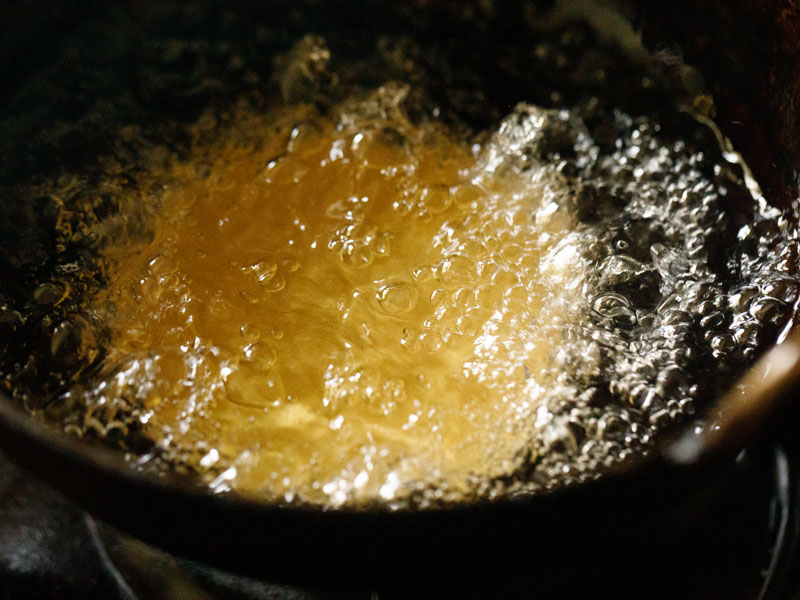
10. It should begin to puff up almost immediately after it hits the hot oil.

11. Requite information technology a nudge with a slotted spoon or spider spoon to keep the puri moving and therefore cooking evenly.
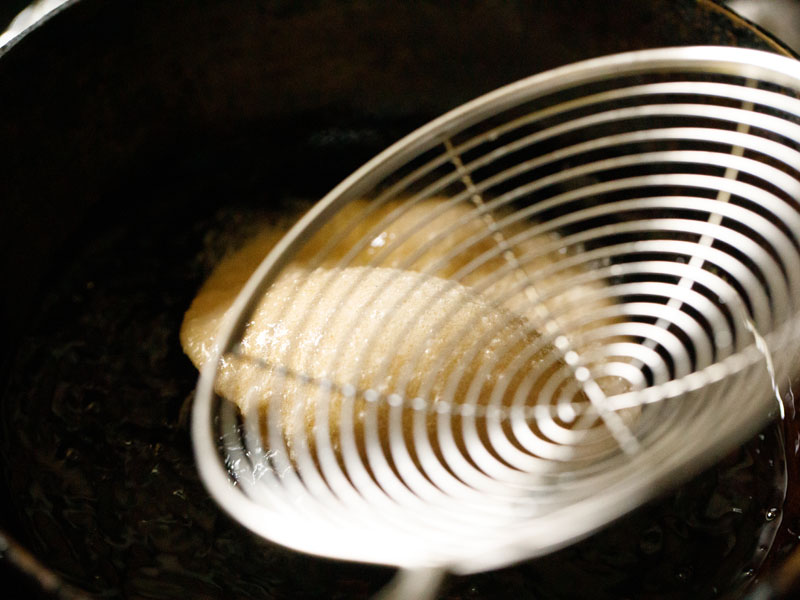
12. Gently printing and nudge the puri on the sides with a slotted spoon or spider spoon to help it puff up completely.
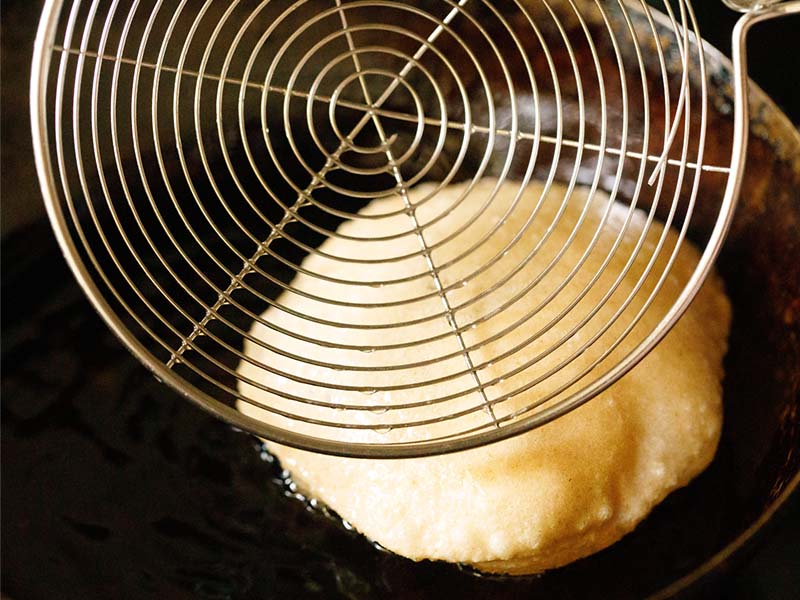
13. Continue to fry for just a minute or two, until the oil stops bubbles and the bottom of the puri is aureate to your liking.
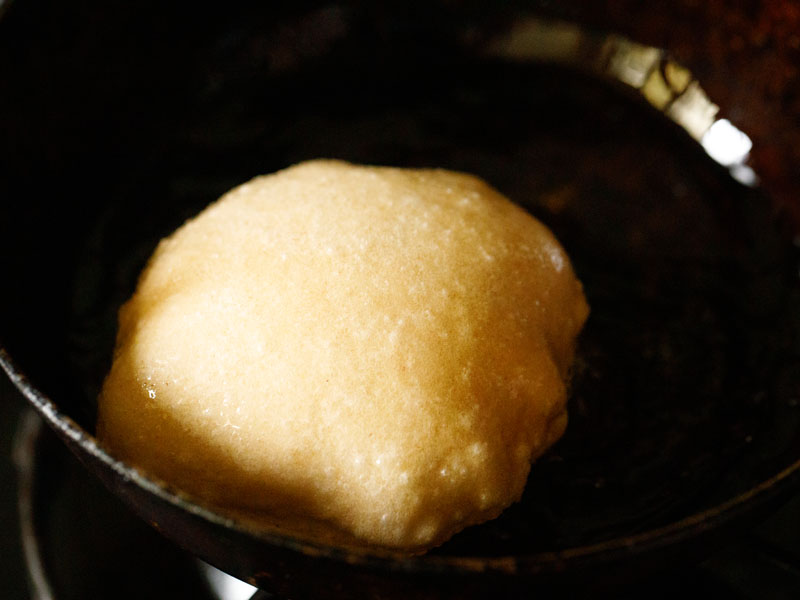
14. Next, turn over the poori and gently press down with the slotted spoon as it fries for a few more seconds. This volition ensure that in that location's a lovely brown color on all sides.
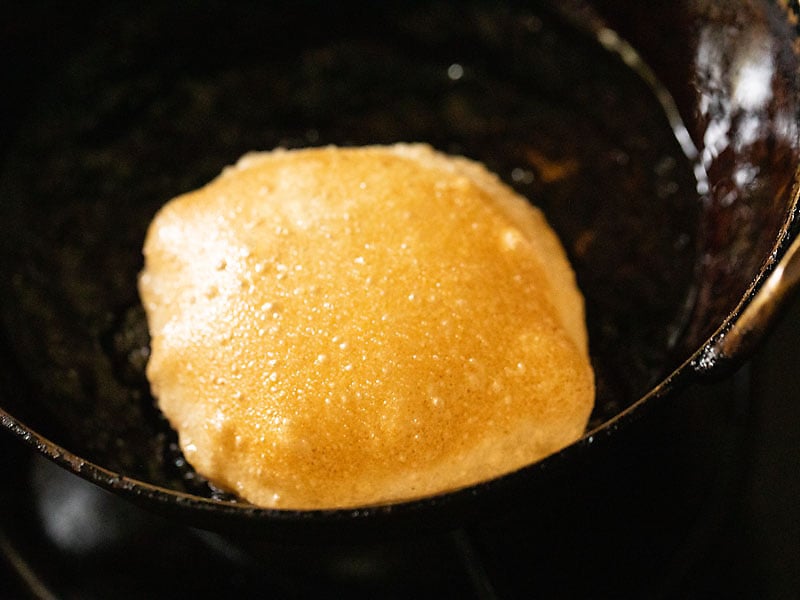
15. So transfer the fried puri to a plate lined with paper towels to blot whatever excess oil.
Fry the remaining poori this way, lowering or increasing the oil temperature as needed to maintain the right level of heat. Very hot oil volition darken the color or in that location may be uneven colour patches on the puri.
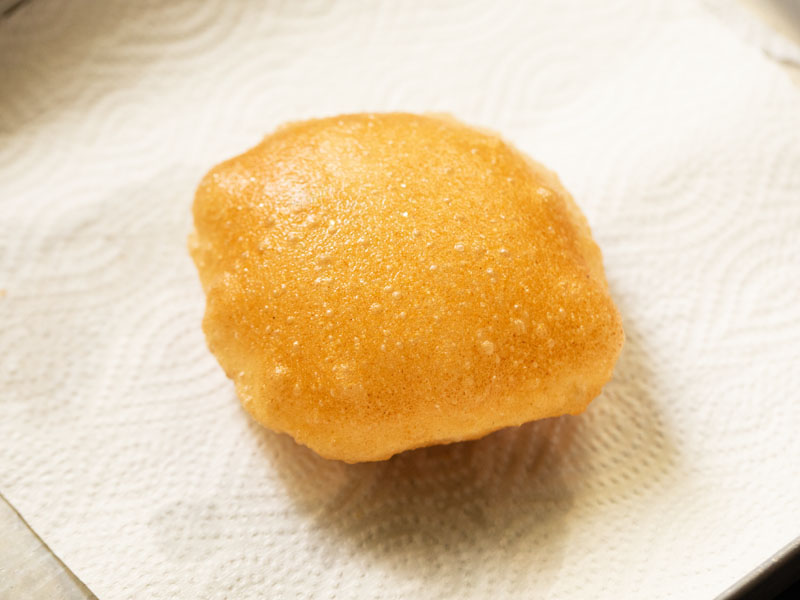
Enjoying Bootleg Poori
16. Serve poori hot with any number of sweet or savory dishes, as I take mentioned below. Or enjoy by themselves for a tasty snack!
To keep puri soft for a few hours, stack them in a steel container, sealing with a lid at room temperature. They volition remain soft and won't become dense and chewy.
Leftovers can be stored in closed container at room temperature for upwardly to 1 twenty-four hours. Because they will lose their crispy exterior, I suggest to rewarm you lot either bake for just a few minutes in the oven.
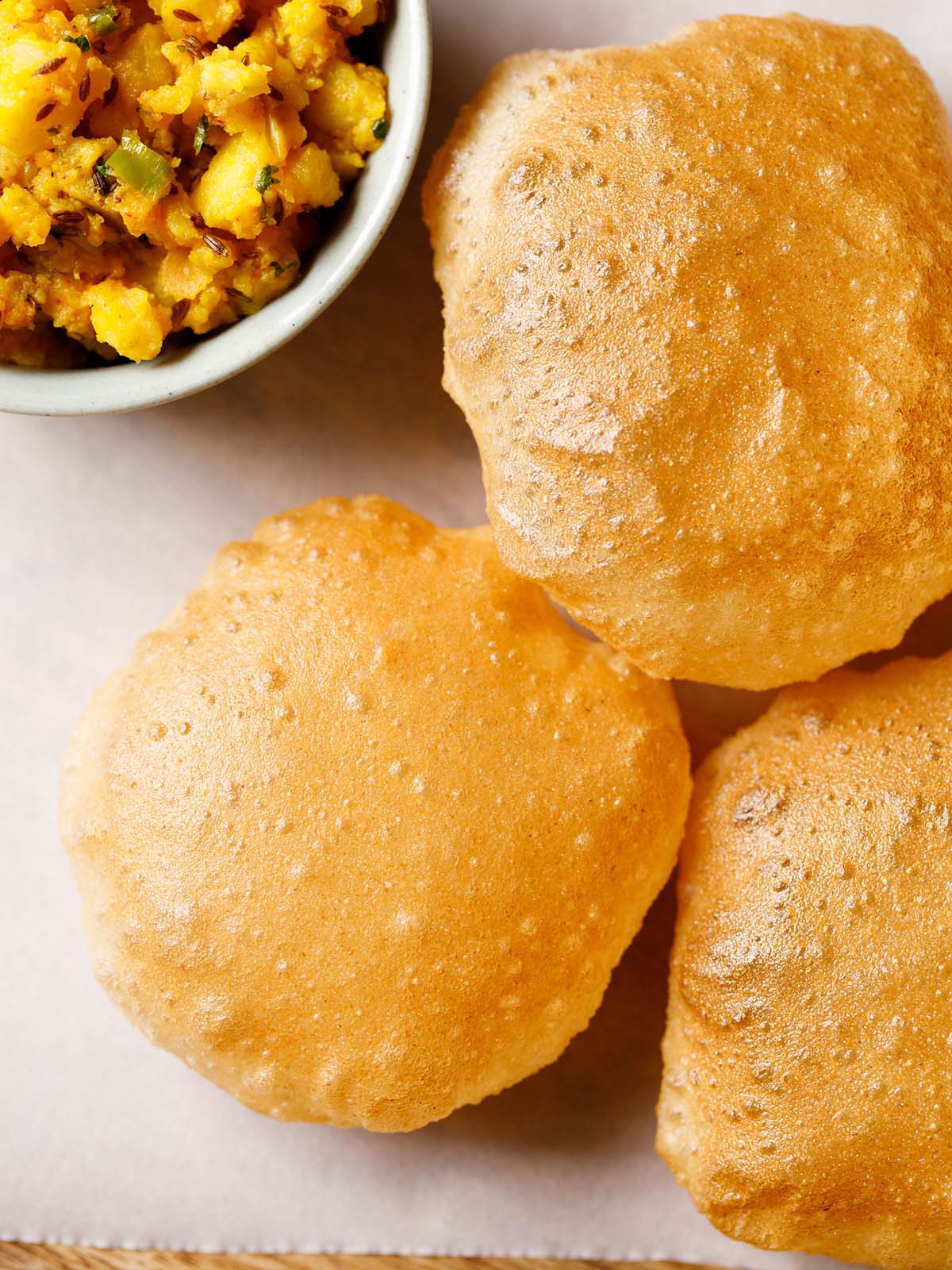
Serving Suggestions
Poori is a common side in Indian cuisine and is typically served with a dry or curried irish potato dish. Crispy fried poori and this saucy, bright Tater Curry are a perfect combination! Together they make a wonderfully comforting and succulent meal that happens to be vegetarian and vegan-friendly.
Non but exercise puri go well with savory dishes, they can exist paired with sweet breakfasts and desserts. Sooji Halwa is a breakfast staple that is sweetened with carbohydrate. A seasonal Indian favorite is Aamras (mango lurid) that tastes and so good with puri. A peachy dessert to enjoy with fried poori is Shrikhand, made with greek yogurt/hung curd and flavored with saffron and cardamom.
They too can be chop-chop fabricated as a side for a filling dejeuner along with curry leftovers and/or a elementary sautéed veggie dish (sabzi).
Other Recipes that Go Well with Poori
- Chana Masala – The classic N Indian back-scratch made with white chickpeas, onions, tomatoes, and spices.
- Veg Kurma – Besides called korma, a saucy mixed vegetable dish with coconut, spices and herbs.
- Kadala Curry – Made with blackness chickpeas, kokosnoot, and lots of spices.
- Aloo Gobi – A classic side dish featuring spiced cauliflower and potatoes.
- Aloo Chole – This very filling breakfast dish includes potatoes and chickpeas.
- Jeera Aloo – A simple side of boiled and sautéed potatoes with cumin, lemon, and coriander leaves.
- Poori Bhaji – Flavor packed potatoes with onions, spices, herbs and tastes best with poori.
Poori Variations
There are and then many fantastic versions of poori breads, here are but a few for you lot effort:
- Masaledar Poori – Spiced puri recipe which is also known as Teekhi Poori.
- Luchi – In the Bengal region, a popular variation of poori recipe with all-purpose flour (maida) is made and usually served with Bengali Dum Aloo.
- Mangalore Buns – Sugariness assistant poori.
- Palak Puri Recipe – With palak puree added to the dough making for a green-colored puri.
- Beetroot Poori Recipe – With Beetroot puree added to the dough giving a vibrant crimson red color poori.
- Rice Puri Recipe – Soft puri made with rice flour makes for a good gluten-free puri recipe.
- Potato puri recipe – Poori stuffed or mixed with spiced mashed potatoes.
- Sweet poori recipe – Made with saccharide or jaggery are likewise known every bit Meethi puri.
- Poori recipe made with grated vegetables or pureed vegetables.
Tips
Expert Tips
- Dough texture: Make sure your dough is nice and tight because a soft dough will not hold its shape likewise when frying. Add together a sprinkle of flour to the dough while kneading if you discover information technology feeling too squishy and loose.
- Rolling: Along with adding a flake of oil to the flattened dough ball, you lot tin can lightly grease the rolling pin with oil to assistance go on it from sticking to the dough. Once more, you don't desire to dust with flour because these particles will burn in the hot oil.
- Frying: It is very important that the oil is exactly at the right temperature. If the oil is too hot the poori will burn. However, if the oil is cold they volition get soggy during the cooking procedure. Frying oil should be between 360-375 degrees Fahrenheit, or 180-190 degrees Celsius. The poori should puff while frying. If not, then something has gone wrong. Either the dough has not been kneaded well, the poori has not been rolled out evenly, or the oil is not hot enough.
- Digestion: Fried food have you feeling a scrap heavy? Add ajwain seeds (carom seeds) to the flour before kneading! Carom seeds (ajwain) are very helpful in digestion, and add a lovely lite season to the puri.
- Crispy texture: For a crispier poori, you can add ¼ cup fine suji (rava or semolina flour) to the dough.
How to cheque if the temperature of oil is correct?
For deep frying, the temperature of the oil should be 180 degrees to 190 degrees Celsius (360 degrees to 375 degrees Fahrenheit) and yous can hands mensurate it with a deep fry or candy thermometer.
If you practise non have a thermometer, you tin check the temperature using these following three methods:
- Firstly, identify a small slice of dough in the hot oil. If it rises to the top gradually and begins to bubble at the surface, the oil is ready. If it rises slowly or is nonetheless at the bottom, and then the oil is common cold and if it rises too fast or briskly, then the oil is very hot.
- Secondly, you can drop a small cube of bread in the oil. If information technology becomes gilded brown in a time-frame of almost sixty seconds, the temperature is right. If it remains pale, the oil would need more than time to oestrus up. If the staff of life becomes very dark or burnt, the oil is besides hot and needs to exist cooled a bit.
- Thirdly, drop a kernel of popcorn in the hot oil. The popcorn will pop at near 180 degrees Celsius (360 degrees Fahrenheit). Once the kernel pops that would be the suitable temperature to brainstorm frying.
FAQs
Why practice puri becomes hard?
Puri becomes hard when it does non puff up in the hot oil while frying. Poori does not puff when the discs are not rolled evenly. Thus they remain apartment and harden when frying.
Why is poori oily?
Frying at a depression temperature of the oil will make poori absorb more oil and it becomes soggy. If the poori cracks when frying, the oil will seep into it making information technology oily.
Which oil is best for frying puri?
Information technology is best to utilize oil having a loftier smoke signal. I would suggest using peanut oil, sunflower oil, vegetable oil, avocado oil, or grape seed oil.
Is puri healthy?
Puri is a deep-fried food. Thus all-time indulged occasionally and not every mean solar day, depending upon your health and body constitution. It is all-time to employ fresh oil for frying. Never utilise reused oil every bit it is extremely unhealthy.
Tin I fry puri in a deep fryer?
Using a deep fryer is non suitable for frying poori. The Indian kadai (similar to a wok) with its open and broad surface is the best utensil to fry poori. The open surface of the kadai helps the poori to rise, expand, and puff up hands in hot oil.
How to make fluffy puris?
Firstly you take to knead the dough very well. So roll the dough balls evenly to the same thickness of most ¼ inch all over. Practice not make the discs also thin or thick. The oil has to exist hot plenty when frying. You can fry at medium to medium-high heat.
Why does puri do non puff?
While rolling, the poori has to be rolled to an even thickness of nigh ¼ inch in a neat circular shape. When frying the oil has to be medium hot that when you place the poori in the hot oil, information technology will come up on the surface and then start puffing up. Gently nudging with a spider spoon or a slotted spoon helps poori to puff up well.
What exactly is the departure in the dough of a roti and poori?
Even though both the roti and puri dough are made with the aforementioned ingredients – flour, water, table salt. The divergence is in the texture and consistency of the dough. A roti or chapati dough is soft and a poori dough is firm and tight.
More Indian Breads
Indian Breads
Naan Recipe | No Yeast Naan Bread
Indian Breads
kulcha recipe

Poori Recipe | Puri
Poori or Puri is a traditional Indian fried unleavened bread fabricated with merely whole wheat flour, common salt, and h2o. Brand crispy, fluffy, and soft poori to enjoy with your favorite meals.
Prep Time ten mins
Melt Time thirty mins
Total Time xl mins
- 3 cups whole wheat flour – 360 grams
- i teaspoon oil or melted ghee (optional)
- 1 teaspoon salt or add as required
- ¾ to 1 cup water or add as required
- oil for deep frying – as required
Prevent your screen from going dark while making the recipe
Making dough
-
In a mixing bowl or on your piece of work-surface, have the whole wheat flour, salt and oil or melted ghee.
-
Add little water at a fourth dimension and knead well to course a dough. The dough should not be soft but strong and tight. You lot can likewise brand a semi-soft dough.
Assembling and rolling
-
Separate the dough into small or medium pieces – virtually 25 to 30
-
Brand into medium sized or slightly small assurance.
-
Spread a scrap of oil on both sides of the dough ball. Spreading oil and not dusting with flour helps the oil to stay make clean and yous won't see dark burnt flour particles inside the oil.
-
Whorl the dough evenly into circles of nearly ¼ inch – neither besides thin nor thick.
-
Identify the rolled poori in a plate and comprehend with a clean kitchen towel, and so that they don't dry upwardly.
Frying
-
Heat oil in a deep frying pan or kadai.
-
When the oil is sufficiently hot so add one poori at a time and fry gently pressing down with the frying spoon or slotted spoon in a circular motion.
-
Turn over when puffed up and fry till gold dark-brown.
-
Serve poori hot with a vegetable back-scratch similar korma or sweet dishes like suji ka halwa or aamras or spud back-scratch.
- Poori Dough: Make certain the puri dough is tight and house as a soft dough volition not hold its shape when frying. Add a sprinkle of flour to the dough while kneading if you detect it feeling too loose.
- Rolling: Forth with calculation a bit of oil to the flattened dough ball, you tin can lightly grease the rolling pin with oil to help keep it from sticking to the dough. Again, do not dust with flour because these particles volition burn down in the hot oil.
- Frying:It is very of import that the oil is exactly at the right temperature. If the oil is too hot the puri will burn down. Nevertheless, if the oil is common cold they will become soggy. Frying oil should exist between 360 to 375 degrees Fahrenheit or 180 to 190 degrees Celsius. The poori should puff while frying. If not, then either the dough has non been kneaded well, the poori has not been rolled out evenly, or the oil is not hot enough.
- Digestion: Add ajwain seeds (carom seeds) to the dough as they are very helpful in digestion, and add a lovely calorie-free aroma to the puri.
- Crispy puri: For a crispier texture, add ¼ cup fine suji (rava or semolina flour) to the dough.
Nutrition Facts
Poori Recipe | Puri
Amount Per Serving (1 poori)
Calories 90 Calories from Fat 54
% Daily Value*
Fatty 6g 9%
Saturated Fatty 1g 6%
Sodium 78mg 3%
Potassium 44mg ane%
Carbohydrates 9g 3%
Fiber 1g 4%
Sugar 1g 1%
Protein 2g 4%
Vitamin B1 (Thiamine) 1mg 67%
Vitamin B2 (Riboflavin) 1mg 59%
Vitamin B3 (Niacin) 1mg v%
Vitamin B6 1mg 50%
Vitamin E 2mg xiii%
Vitamin Grand 1µg 1%
Calcium 4mg 0%
Vitamin B9 (Folate) 5µg one%
Fe 1mg 6%
Magnesium 16mg four%
Phosphorus 43mg 4%
Zinc 1mg 7%
* Percentage Daily Values are based on a 2000 calorie diet.
This recipe mail service is from the athenaeum (April 2014) and has been republished and updated on 10 December 2020 with newer photos, my expert tips and FAQs.
Welcome to Dassana'south Veg Recipes. I share vegetarian recipes from India & around the World. Having been cooking for decades and with a professional groundwork in cooking & baking, I help you to make your cooking journey easier with my tried and tested recipes showcased with pace by step photos & enough of tips & suggestions.
Source: https://www.vegrecipesofindia.com/poori-a-kind-of-fried-indian-bread/
Post a Comment for "Bread in Bread Again Dum Dum Dum Dum Bread Again Bread Again Te Worlds Most Famous Bread"